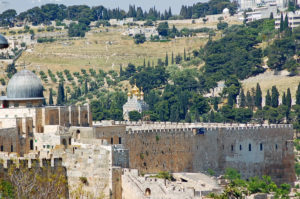
Southern end of Temple Mount in Jerusalem (Photo by Don Knebel)
At the time of Jesus, King Herod, who ruled on behalf of Rome, refurbished the Jewish Second Temple and significantly extended the Temple Mount on which it rested. The Temple Mount lies just west of the Mount of Olives. Many Jewish people believe their expected Messiah will walk down the Mount of Olives toward the Temple. In anticipation, Jews have long been buried on the Mount of Olives. Early followers of Jesus welcomed him as the Messiah as he rode a donkey down the Mount of Olives toward the Temple on the day Christians call Palm Sunday. Jesus then preached from the southern steps of the Temple Mount.
In 70 A.D., the Romans crushed the First Jewish Revolt, razed Jerusalem and demolished the Second Temple. After the Second Jewish Revolt in 135, Romans rebuilt the city, named it Aelia Capitolina and barred Jews from entering except on one day a year. After Christianity became legal in the Roman Empire, Christians began settling in Aelia Capitolina, reportedly using the barren Temple Mount as their garbage dump. Muslims captured the city in 638, named it after Jerusalem and built the Al-Aqsa Mosque near the southern end of the Temple Mount. Some Muslims believe the resurrected dead at the end of time will walk across a narrow bridge suspended between the Mount of Olives and Al-Aqsa Mosque, which has become the third holiest site in Islam. In 1888, Russian Orthodox Christians opened the Church of Mary Magdalene on the Mount of Olives across the Kidron Valley from the Temple Mount. The gold-domed church, Al-Aqsa Mosque and the southern steps of the Temple Mount can all be seen from a spot in what is now East Jerusalem.